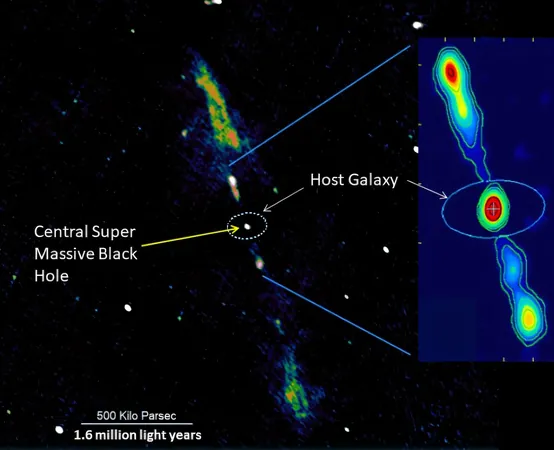
Shocking Discovery: Milky Way's Potential Future Revelations Unveiled!
2025-03-21
Author: John Tan
An astonishing cosmic anomaly has emerged, raising alarming questions about the future of our very own Milky Way galaxy. A dedicated international team of astronomers, spearheaded by CHRIST University in Bangalore, discovered a massive spiral galaxy nearly 1 billion light-years away, harboring an extraordinary supermassive black hole that weighs in at billions of times the mass of our sun. This colossal black hole is responsible for unleashing enormous radio jets that stretch an unimaginable 6 million light-years across, a record-breaking size for any spiral galaxy!
A Paradigm Shift in Our Understanding of Galactic Evolution
Lead author, Professor Joydeep Bagchi of CHRIST University, highlights the significance of this discovery, stating, "This is not just a peculiar find; it compels us to reevaluate how galaxies evolve and how supermassive black holes influence their surroundings.” He poses a crucial question: could the Milky Way one day find itself emitting high-energy jets that could threaten life as we know it?
In a groundbreaking study published in the Monthly Notices of the Royal Astronomical Society, researchers meticulously analyzed the structure and evolution of the spiral galaxy identified as 2MASX J23453268-0449256, which dwarfs the Milky Way by threefold. Utilizing observations from renowned telescopes including the Hubble Space Telescope and the Giant Metrewave Radio Telescope, the scientists unveiled the presence of an enormous black hole and unprecedented radio jets, challenging established notions of galactic behavior.
Despite the violent nature of these jets, 2MASX J23453268-0449256 has remarkably maintained its serene appearance, showcasing well-defined spiral arms and an undisturbed stellar ring—a striking contradiction to what was previously understood about the dynamics of spiral galaxies undergoing such extreme conditions.
This remarkable galaxy is also enveloped by a vast halo of hot, X-ray-emitting gas, which hints at a complex history. As this halo gradually cools, the black hole’s jets act like a cosmic furnace, paradoxically inhibiting star formation in an environment rich in star-making material.
The Milky Way: A Comparative Analysis
Our Milky Way hosts a black hole known as Sagittarius A* (Sgr A*), weighing approximately 4 million solar masses. Currently, Sgr A* is in a dormant state, but this could change dramatically if it were to encounter gas clouds or stars—events known as Tidal Disruption Events (TDE)—which have been documented in other galaxies. If a large jet were to emerge from Sgr A*, its ramifications could be dire; a single powerful jet directed towards Earth could strip planetary atmospheres and inflict severe radiation damage, potentially leading to widespread extinction.
Astronomers speculate that the Milky Way might have experienced similar radio jets in its past. While it’s possible for such jets to manifest again in the future, the timeline remains uncertain and dependent on various cosmic factors.
Insights into Dark Matter
In addition to their astonishing findings, the researchers noted that 2MASX J23453268-0449256 contains ten times more dark matter compared to the Milky Way. This dark matter plays a critical role in stabilizing the rapid spin of the galaxy, thereby unveiling a crucial balance between dark matter, black hole activity, and galactic structure.
Co-author Shankar Ray, a Ph.D. student at CHRIST University, emphasized that this research could unlock essential insights into the elusive forces that govern the universe, including dark matter, the long-term fate of galaxies, and even the origins of life itself.
"Ultimately, this study brings us closer to unraveling the mysteries of the cosmos, serving as a reminder that the universe continues to hold astonishing surprises beyond our current comprehension!"
Stay tuned for updates as we continue to explore the cosmos and the thrilling potential futures that await our Milky Way!





 Brasil (PT)
Brasil (PT)
 Canada (EN)
Canada (EN)
 Chile (ES)
Chile (ES)
 Česko (CS)
Česko (CS)
 대한민국 (KO)
대한민국 (KO)
 España (ES)
España (ES)
 France (FR)
France (FR)
 Hong Kong (EN)
Hong Kong (EN)
 Italia (IT)
Italia (IT)
 日本 (JA)
日本 (JA)
 Magyarország (HU)
Magyarország (HU)
 Norge (NO)
Norge (NO)
 Polska (PL)
Polska (PL)
 Schweiz (DE)
Schweiz (DE)
 Singapore (EN)
Singapore (EN)
 Sverige (SV)
Sverige (SV)
 Suomi (FI)
Suomi (FI)
 Türkiye (TR)
Türkiye (TR)
 الإمارات العربية المتحدة (AR)
الإمارات العربية المتحدة (AR)